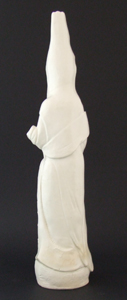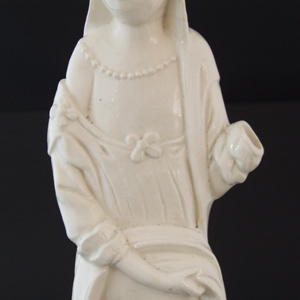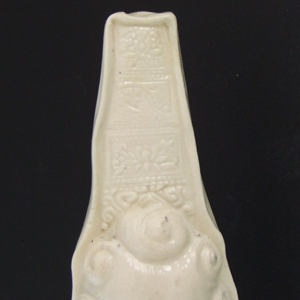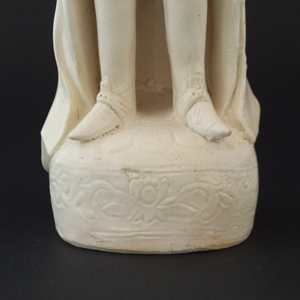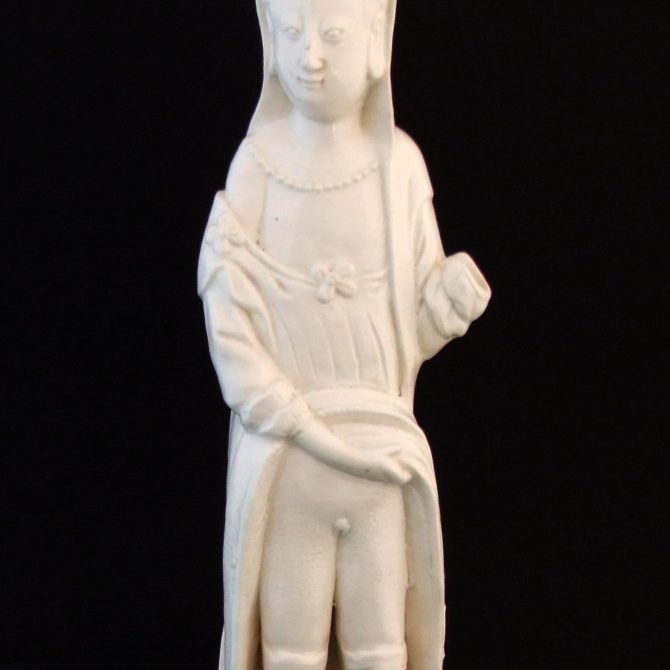
KANGXI 1662 – 1722 Blanc de Chine Porcelain
A Rare Large Kangxi Blanc de Chine Porcelain Model of a Well Dressed Lady Presumed to be a Prostitute or as Donnelly Describes Her a “Lascivious Woman”, Dehua Kilns, Fujian Province, Kangxi Period c.1690-1710. This Very Tall Blanc de Chine Figure of a European was Probably Inspired by the Prints of the Bonnart Family (Print Makers and Publishers) of Paris. She is Wearing a `Mantua` Which is Falling off Her Shoulder While She Uses One Hand to Expose Herself. There is a Socket for the Missing Arm, Which was Possibly Holding a Fan. Her Tall Hair Style is Typical of the Fontange Style of the 1690s`.
SOLD
- Condition
- Broken through her lower neck and re-stuck. The detachable arm is missing.
- Size
- Height : 40.5 cm (16 inches)
- Provenance
- From a European Private Collection of Figures and Chinese Export Porcelain.
- Stock number
- 23410
- References
- For a very similar Blanc de Chine porcelain figure see : Chinese Trade Porcelain (Michel Beurdeley, Charles E. Tuttle Company. No ISBN number, 1962) page 158, plate 45. A further example now in the British Museum which they date as c.1750-1775 comes from the Donnelly collection. Donated in 1980, 1980,0728.297. It was exhibited, see : Ancient Chinese Trade Ceramics from The British Museum (Regina Krahl and Jessica Harrison-Hall, National Museum of History, Republic of China,1994. ISNB 957-00-3623-0) page172 and 173, plate 74. For a further figure described as ex Newbon, London ; present whereabouts unknown : see Blanc de Chine (P.J. Donnelly, Faber and Faber, 1969. ISBN 571-08078-2) plate 121 A. Dated to 1675-1725.
Information
This interesting and rare Blanc de Chine figure must have been made in very small numbers. Very few survive and to my knowledge none have remained with their detachable arm. The engraving that was presumably the source for this figure is not know. The Bonnart family produced a large number of engravings of fashionable women during the last decades of the 17th century and the very beginning of the 18th century. They frequently show ladies wearing a Mantua and Fontange hair style.
The Mantua (Clothing) :
The Mantua sometimes referred to as a bodice was more coat like in construction. It was originally an informal style of clothing that was introduced into the French court by Louis the XIV in the late 1670`s. The name is possibly derived from the old French word for coat Manteuil. The draped form displayed silks to their best advantage. The sleeves were cut in one piece with the back and front, it was pleated at the shoulders and fell to the waist. The Sleeves were elbow length and cuffed, often with overlapping layers of lace showing from the under garment. Some Matuas were made of `bizarre silk` including one dated 1708 (Metropolitan Museum of Art`s Costume Institute). The 17th century form of Mantua changed over time, in the 18th century extreme examples were made. For example in the well known painting by Gainsborough of c.1750 depicting Mr and Mrs Andrews, the Mantua is so wide it fills up a seat made for two, Mr Andrews has to Stand.
Fontange (Hair Style):
A fontange, or frelange, is a high headdress popular during the end of the late 17th and early 18th centuries in Europe. Technically, fontanges are only part of the assembly, referring to the ribbon bows which support the frelange. The frelange was supported by a wire framework called a commode. A surviving example of a frelange headdress with fontanges and commode in situ is that worn by the 1690s fashion doll Lady Clapham of c.1690-1700 (Victoria and Albert Museum, in the British Galleries, Museum number T.846-1974). In England, the style was popularly known as a `top-knot`, versions of which were worn by ladies of all ranks, from the Queen downwards to kitchen maids, making it an easy target for satire and criticism.
The fontange is said to be named for the Duchesse de Fontange (Marie Angélique de Scorailles 1661-1681), a mistress of King Louis XIV of France. One version of the story is that after losing her cap while hunting with the King, the Marquise tied her hair up using a ribbon in a manner that pleased him, and this was imitated by the other ladies at court, subsequently spreading across Europe. What started out as a simple headdress of folded ribbon in the 1680s became, with additional fabric, lace and trimmings, taller and more complex, increasingly difficult to create and wear. Despite its courtly origins, fontanges were forbidden to be worn at French state occasions, although the English court accepted them, with Queen Mary having her portrait painted wearing one. The term "fontange" is also used by some writers to refer to the associated hairstyle or the combination of headdress and hairstyle.The `fontange coiffure` was a hairstyle where the front of the hair was worn curled and piled high above the forehead in front of the frelange, which was always higher than the hair. Sometimes the hairstyle was supported by a wire framework called a pallisade. Addapted from http://en.wikipedia.org/wiki/Fontange
